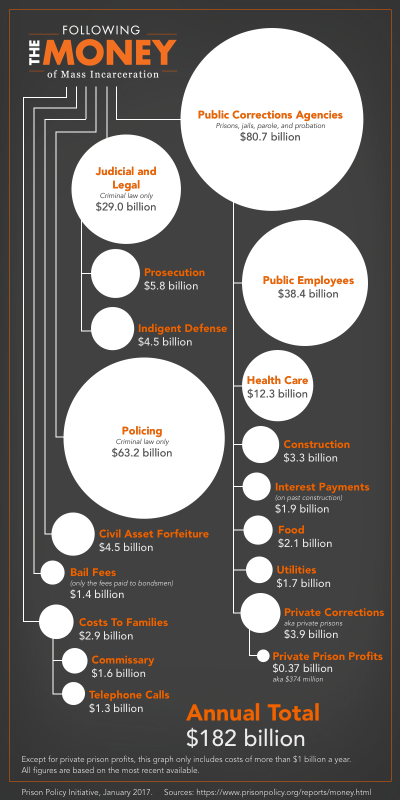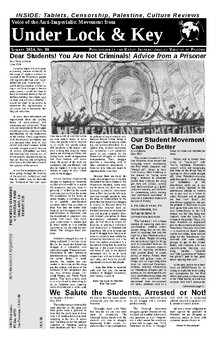
Labor Aristocracy and White Nationalism Benefit from Prisons, not Private Corporations

In analyzing the system of social control in the United $tates, it is imperative that we follow the correct line. The position of many today is to argue that the injustice system is based on a “Prison-Industrial Complex” [which we at MIM(Prisons) reject]. A new report, “Following the Money of Mass Incarceration” by Peter Wagner and Bernadette Rabuy, provides additional evidence to back up our position.
Prisons are generally a complex web of concentration camps for oppressed semi-colonies, rather than an economically profitable industry. Indeed, there are some profits to be made (and capitalists/imperialists are good at finding their niches), but overall, the purpose of the injustice system today is population control.
As Wagner and Rabuy point out in their article: “In this first-of-its-kind report, we find that the system of mass incarceration costs the government and families of justice-involved people at least $182 billion every year.”(1) This $182 billion includes the $374 million in profits received by the private prison industry. The profits to these numerically few stakeholders hardly represent a systematic profit-generating enterprise. In fact, in the graph summing up their research, the authors had to make an exception to the cut off for significant portions of the U.$. prison budget in order to even include private prisons on it!
“This industry is dominated by two large publicly traded companies – CoreCivic (which until recently was called Corrections Corporation of America (CCA)) and The GEO Group — as well as one small private company, Management & Training Corp (MTC). We relied on the public annual reports of the two large companies, and estimated MTC’s figures using records from a decade-old public record request.”(1)
Private prison corporations have very little to gain in the prison business, which is why the vast majority (up to 95%) are still public prisons.(2) The Amerikkkan government (i.e. taxpayers) fronts the bill for the $182 billion. The few economic beneficiaries of the prison industry are commissary vendors, bail bond companies, and specialized telephone companies. As Wagner and Rabuy demonstrate, these are the multi-billion dollar industries. And they, of course, benefit, whether the prisons are private or not!
Why would the imperialist system be willing to spend almost $200 billion a year at the loss of widespread economic labor and consumers? For, as is shown: “Many people confined in jails don’t work, and four state prison systems don’t pay at all.”(1)
As Wagner points out in an article from 7 October 2015:
“Now, of course, the influence of private prisons will vary from state to state and they have in fact lobbied to keep mass incarceration going; but far more influential are political benefits that elected officials of both political parties harvested over the decades by being tough on crime as well as the billions of dollars earned by government-run prisons’ employees and private contractors and vendors.
“The beneficiaries of public prison largess love it when private prisons get all of the attention. The more the public stays focused on the owners of private prisons, the less the public is questioning what would happen if the government nationalized the private prisons and ran every facility itself: Either way, we’d still have the largest prison system in the world.”(3)
The capitalists don’t economically gain from the supposed “Prison-Industrial Complex”, but the politicians gain from the white Amerikkkan obsession with “crime”. Taking this into account, we find the truth hiding behind Wagner and Rabuy’s cryptic phrase: “To be sure, there are ideological as well as economic reasons for mass incarceration and over-criminalization.”(1)
We’ve already looked at the economic reasons – power groups like the bail bond companies and commissary vendors are obviously looking to make a profit. So what are the ideological reasons?
When we look at prison populations (whether private or public), we can see where mass incarceration gets its impetus. The vast majority of prisoners are New Afrikans, Chican@s, and peoples of the First Nations (even though euro-Amerikkkans are the majority of the U.$. population). The prison is not a revenue racket, but an instrument of social control. The motivating factor is domination, not exploitation.
If we’re following the money though, then we need look at how spending breaks down. Wagner and Rabuy present the division of costs as: the judicial and legal costs, policing expenditures, civil asset forfeiture, bail fees, commissary expenditures, telephone call charges, “public correction agencies” (like public employees and health care), construction costs, interest payments, and food and utility costs.
The authors outline their methodology for arriving at their statistics and admit that “[t]here are many items for which there are no national statistics available and no straightforward way to develop a national figure from the limited state and local data.”(1) Despite these obvious weaknesses in obtaining concrete reliable data, the overwhelming analysis stands.
Wagner and Rabuy discuss the private prison industry at the end of the article. Here, they write:
“To illustrate both the scale of the private prison industry and the critical fact that this industry works under contract for government agencies — rather than arresting, prosecuting, convicting and incarcerating people on its own — we displayed these companies as a subset of the public corrections system.”(1)
As was argued in “MIM(Prisons) on U.S. Prison Economy”, “[i]f prison labor was a gold mine for private profiteers, then we would see corporations of all sorts leading the drive for more prisons.”(2)
In light of this, the injustice system in the United $tates and the prisons (both private and public) are used by the government to oppress national minorities. And the government is rewarded with enthusiasm and renewed vigor by white Amerikkkans, who goose-step into formation with ecstasy when racist politicians like Donald Trump go on about being “tough on crime”.
MIM Thought stresses the focus on imperialism both inside and outside the United $nakes. The network of prisons is no exception – imperialism here functions as a method of control by Amerikkkans of oppressed nations. As the statistics presented by Wagner and Rabuy clearly demonstrate, there is no “Prison Industrial Complex.” There is a systematic attempt to destroy individuals, communities, and nations.(4)
Related Articles:This article referenced in:








